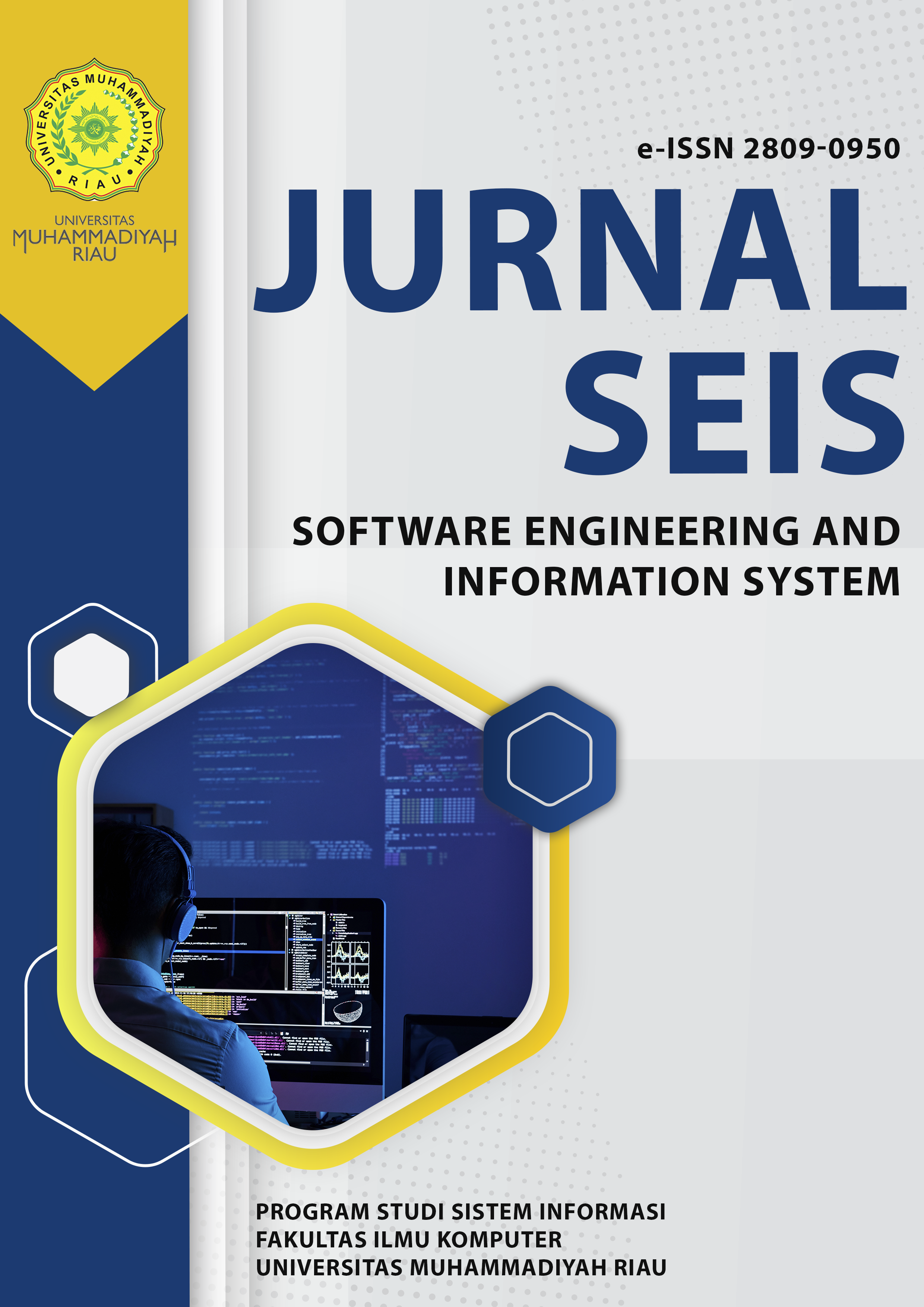MODEL KLASIFIKASI JARAK MANHATTAN PADA PENGENALAN CITRA SISTEM BAHASA ISYARAT BAHASA INDONESIA
DOI:
 https://doi.org/10.37859/seis.v5i2.9466
https://doi.org/10.37859/seis.v5i2.9466
Abstract
This study aims to design and implement an image recognition system for Sistem Isyarat Bahasa Indonesia (SIBI) by applying the Manhattan distance classification method. Sign language serves as a vital means of visual communication for individuals with hearing impairments and disabilities. However, public understanding of this language remains limited, often leading to ineffective communication between hearing and non-hearing communities. Therefore, an assistive system capable of accurately recognizing sign language is highly needed. The Manhattan method was selected due to its simplicity and efficiency in calculating distances between data points. The dataset used in this study was obtained from the Kaggle website, consisting of 130 training images and 130 testing images, each representing 26 alphabet letters in the SIBI system. All images underwent initial preprocessing using Jupyter Notebook, including resizing, background removal, and conversion to grayscale to facilitate feature extraction. The grayscale images were then transformed into histograms and normalized to maintain a consistent value scale. The classification process was carried out by computing the Manhattan distance between the test and training image histograms. The system was developed using MATLAB R2015a, featuring a user interface that displays classification results directly. The test results showed that out of 130 test images, 104 were accurately recognized, achieving an accuracy rate of 80%. These findings indicate that the Manhattan method is effective for use in image-based sign language recognition systems. The developed system is expected to serve as an inclusive and educational tool to enhance communication between the hearing-impaired community and the general public. Further development may involve integrating additional methods and expanding the dataset.
Downloads
References
Budiman, S. N., Lestanti, S., Yuana, H., & Awwalin, B. N. (2023). SIBI (Sistem Bahasa Isyarat Indonesia) berbasis Machine Learning dan Computer Vision untuk Membantu Komunikasi Tuna Rungu dan Tuna Wicara. Jurnal Teknologi Dan Manajemen Informatika, 9(2), 119–128. https://doi.org/10.26905/jtmi.v9i2.10993
Daniels, S., Suciati, N., & Fathichah, C. (2021). Indonesian Sign Language Recognition using YOLO Method. IOP Conference Series: Materials Science and Engineering, 1077(1), 012029. https://doi.org/10.1088/1757-899x/1077/1/012029
Dhewa, O. A., Yuliana Utama, S., Nasuha, A., Gunawan, T. S., Nugraha, G., & Pratama, P. (2024). Real-Time Classification Improvement of Indonesian Sign System Letters (SIBI) Using K-Nearest Neighbor Algorithm. Science & Technology Asia, 29(3). https://doi.org/10.14456/scitechasia.2024.49
Fitriani, L., Kurniadi, D., & Rajab, I. S. (2025). Implementation of Machine Learning Model to Detect Sign Language Movement in SIBI Learning Media. Teknika, 14(1), 57–65. https://doi.org/10.34148/teknika.v14i1.1159
Hassan, M. M., Hussein, H. I., Eesa, A. S., & Mstafa, R. J. (2021). Face recognition based on gabor feature extraction followed by fastica and lda. Computers, Materials and Continua, 68(2), 1637–1659. https://doi.org/10.32604/cmc.2021.016467
Kurniawan, R., & Arie Wijaya, Y. (2025). Journal of Artificial Intelligence and Engineering Applications YOLOv8 Algorithm to Improve the Sign Language Letter Detection System Model (Vol. 4, Issue 2).
L. Galib, S., S. Tahir, F., & A. Abdulrahman, A. (2021). Detection Face Parts in Image Using Neural Network Based on MATLAB. Engineering and Technology Journal, 39(1B), 159–164. https://doi.org/10.30684/etj.v39i1b.1944
Permana, D., & Sutopo, J. (2023). APLIKASI PENGENALAN ABJAD SISTEM ISYARAT BAHASA INDONESIA (SIBI) DENGAN ALGORITMA YOLOv5 MOBILE APPLICATION ALPHABET RECOGNITION OF INDONESIAN LANGUAGE SIGN SYSTEM (SIBI) USING YOLOv5 ALGORITHM. Jurnal SimanteC, 11(2), 231–240.
Rudy Asrianto, & Araafy2. (2022). PERANCANGAN SISTEM PAKAR UNTUK IDENTIFIKASI KERUSAKAN HARDWARE DAN SOFTWARE PADA SMARTPHONE DENGAN MENGGUNAKAN METODE FORWARD CHAINING. Jurnal Software Engineering and Information Systems (SEIS), 2.
Saleh, A., F K Sibero, A., & H G Manurung, I. (2021). Pengenalan Tanaman Herbal Menggunakan Algoritma Learning Vector Quantization Dan Manhattan Distance. Jurnal TEKESNOS, 3(2), 271–276.
Septiarini, A., Hamdani, H., Sauri, M. S., & Widians, J. A. (2022). Image processing for maturity classification of tomato using otsu and manhattan distance methods. Jurnal Informatika, 16(3), 112. https://doi.org/10.26555/jifo.v16i1.a21985
Sholawati, M., Auliasari, K., & Ariwibisono, FX. (2022). Pengembangan Aplikasi Pengenalan Bahasa Isyarat Abjad Sibi Menggunakan Metode Convolutional Neural Network (Cnn). JATI (Jurnal Mahasiswa Teknik Informatika), 6(1), 134–144. https://doi.org/10.36040/jati.v6i1.4507
Soltani, O., & Benabdelkader, S. (2022). Euclidean distance versus Manhattan distance for skin detection using the SFA database. In Int. J. Biometrics (Vol. 14, Issue 1).
Sunardi, Abdul Fadlil, & Novi Tristanti. (2022). The Application of The Manhattan Method to Human Face Recognition. Jurnal RESTI (Rekayasa Sistem Dan Teknologi Informasi), 6(6), 939–944. https://doi.org/10.29207/resti.v6i6.4265
Sunardi, Fadlil, A., & Tristanti, N. (2023). Comparative analysis of euclidean, manhattan, canberra, and squared chord methods in face recognition. Revue d’Intelligence Artificielle, 37(3), 593–599. https://doi.org/10.18280/ria.370308
Downloads
Published
Versions
- 2025-10-15 (2)
- 2025-08-20 (1)
How to Cite
Issue
Section
License
Copyright (c) 2025 alfa rado andre yusa saka tory

This work is licensed under a Creative Commons Attribution-ShareAlike 4.0 International License.
Copyright Notice
An author who publishes in the Journal of Software Engineering and Information System (SEIS) agrees to the following terms:
- Author retains the copyright and grants the journal the right of first publication of the work simultaneously licensed under the Creative Commons Attribution-ShareAlike 4.0 License that allows others to share the work with an acknowledgement of the work's authorship and initial publication in this journal
- Author is able to enter into separate, additional contractual arrangements for the non-exclusive distribution of the journal's published version of the work (e.g., post it to an institutional repository or publish it in a book) with the acknowledgement of its initial publication in this journal.
- Author is permitted and encouraged to post his/her work online (e.g., in institutional repositories or on their website) prior to and during the submission process, as it can lead to productive exchanges, as well as earlier and greater citation of the published work (See The Effect of Open Access).
Read more about the Creative Commons Attribution-ShareAlike 4.0 Licence here: https://creativecommons.org/licenses/by-sa/4.0/.










